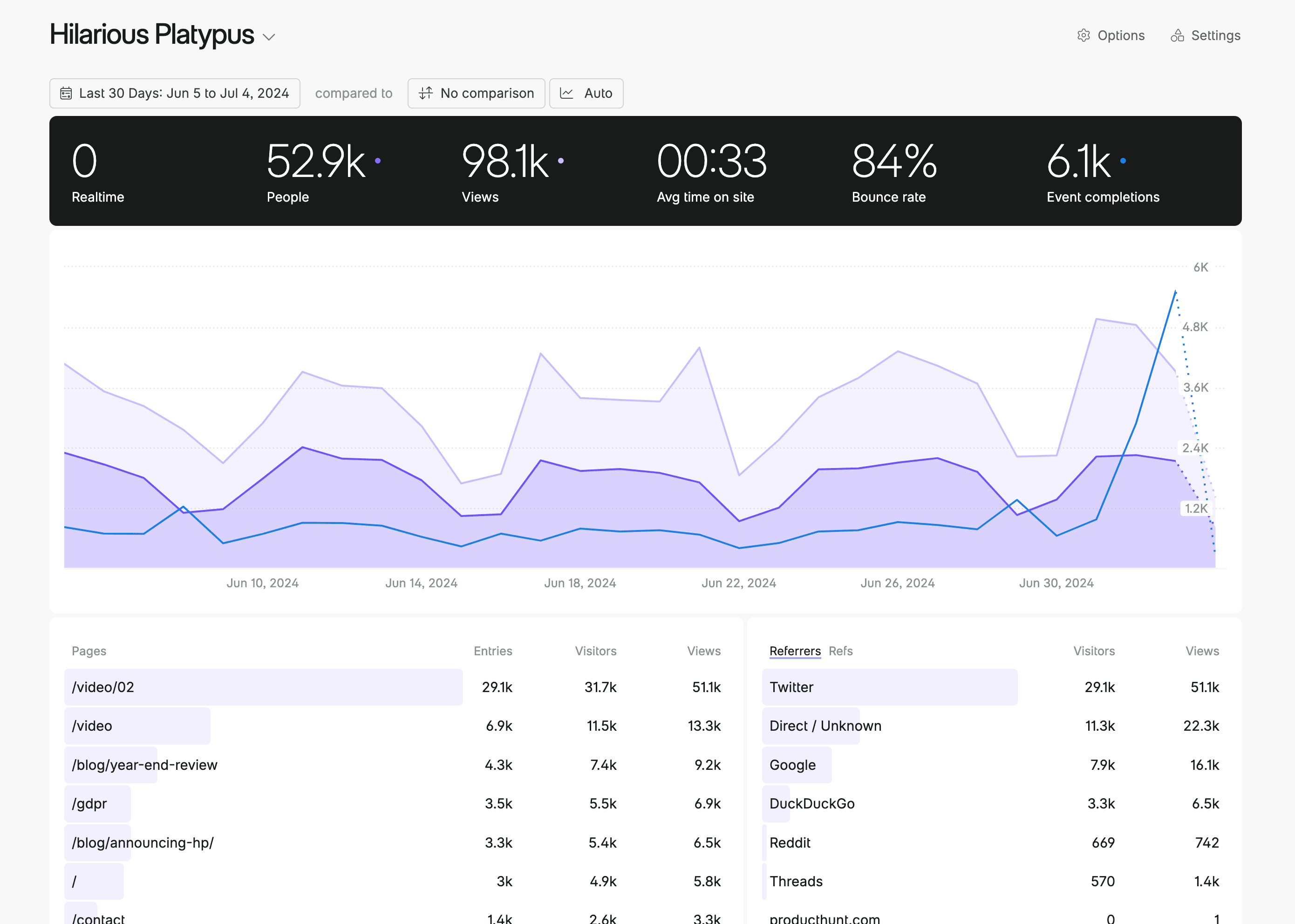Dashboard explained
First, let's start with what Fathom Analytics is: simple, GDPR-compliant website analytics that shows you data about your website on a dashboard or email report. If you're just looking for what the words on the dashboard mean, read about those here.
Here's a video explanation of this content if you're a visual learner.

To learn more about what analytics matter to your website, give our blog post on this subject a read.
If you want to visit a page or referrer from your dashboard To open a page or referrer instead of creating a filter, hold down Command (Mac) or Windows (PC) and click the link.
Time zones
Currently, we collect data in UTC +0 and then load your dashboard based on your local timezone. Our hashes for unique visitors are reset at midnight UTC +0.
Changing the graph
If you click on a value in the totals box (the box with big numbers at the top of your dashboard), you can show or hide values on the graph for visitors, views, time, bounce, or event completions (if you have at least one event completion).
Dark mode
By default, the dashboard is shown in light or dark mode based on your site settings. You can override this by changing the settings in 'Settings', 'Account', and adjusting 'Toggle dark mode.'
Details
When you click the icon in the bottom/left of any box on your dashboard, you can see the details of that box. The details page shows you 50 rows per page and some boxes (like Pages) will show you extra details like bounce rate per page and avg time spent on each page.
What does People mean?
People is the number of unique individuals who visited your website during a 24-hour period.
For example, if Sally and John both visit your site and each clicks on three pages, you'll see 2 People (Sally and John) and 6 views (two people × three pages each).
To protect privacy, we reset how we identify a person every 24 hours (you can read about salts and hashes here).
What is a page visitor?
Page visitors (in the Pages box) are the number of people who visited a specific page on your site. Each page Sally or John visits counts as one unique page visitor using the People example above. If either of them visited the same page twice, it'd still only count as a single page visitor, but it'd result in multiple views.
What are views?
Views are the number of times a page loads on your website. So in the above example, Sally and John visited three pages each, so it's six views total.
Note: views are essential to understand since our pricing plans are based on page views (average number of views per month, plus event completions and API requests).
How is average time on page calculated?
Fathom calculates the average time on a page by logging the time between views. For example, if you clicked on the homepage, then 2 minutes later, you clicked on the about page, the average time on the page is 2 minutes.
In this method, we don't calculate the time on the final page (since no other page has been clicked).
How is bounce rate calculated?
We figure out bounce rate by looking at single page sessions and then dividing by total sessions.
For example, if 100 people visited your site and 50 left after only visiting a single page, your bounce rate is 50%.
How are events calculated?
Events (or goals) in Fathom are things you want to collect data about, which aren't just page views. Button clicks, form submissions, and even e-commerce can be set up as events in Fathom.
Conversion rates for events are calculated by taking the number of times the event was triggered and dividing it by the total number of page views.
Unique completions are the number of times a visitor completed an event (since visitors are unique people).
What is "Realtime"?
Realtime shows how many people are actively viewing your site right now. Click it to open a purple box showing which pages they're on and where they came from (referrers).
Realtime data updates in 5-minute intervals. If someone stays on a page longer than 5 minutes, they'll drop out of the realtime count. If they move to another page, they'll show up again.
Direct/unknown
Direct/unknown in the Referrers box shows you how many people visited your site without a referrer set. That could mean they came directly to your site (i.e. they typed in your URL), came from an email or app, or a referrer simply wasn't set (some sites do this, and no analytics software can control it).
Note that we only started recording Directs/unknown data in March 18, 2021, so if you're viewing data that includes pre-March 18, 2021 data, it won't include this data. And if you view a date range that includes date before March 18 and after, the sum of the referrer visitors won't add up to the total visitors as we don't have data prior to that date (so we only show the data we have).
What is a "ref"?
In a URL, a "ref" parameter typically refers to a referral source that is appended to the end of the URL. This parameter is used to let you know the referral source that directed the visitor to the website.
For example, if you click on a link for a product promotion, the URL for the landing page might include a "ref" parameter such as "?ref=mysite" at the end of the URL. This code indicates that your visit to the landing page came from a specific source, such as a particular website, email campaign, or social media platform.